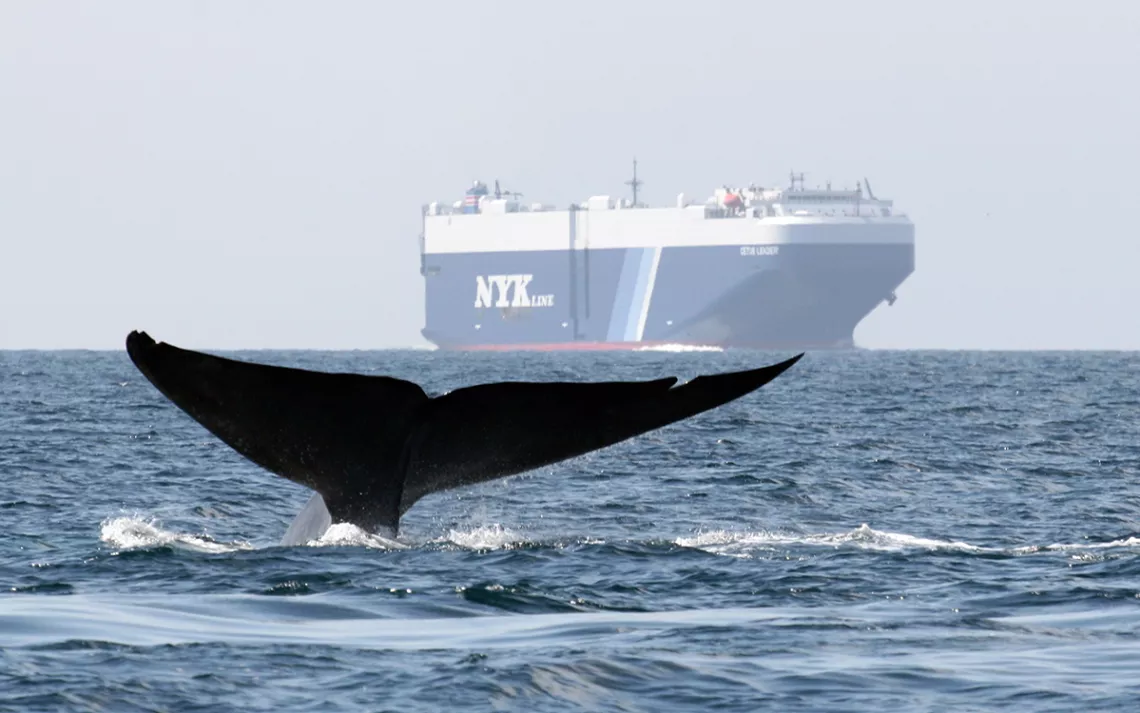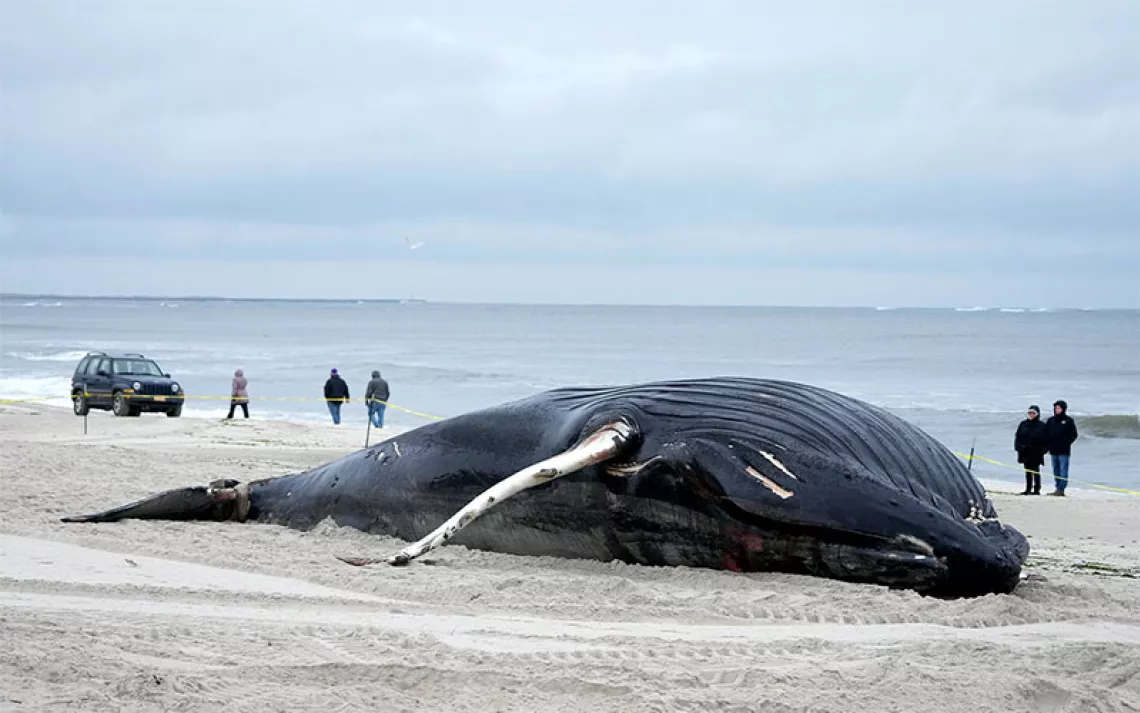New Restrictions Seek to Separate Ships From Whales
Keeping ships away from whale feeding grounds and corridors provides needed protection

The combination of high cargo ship traffic, feeding areas, and migratory whale routes results in an increased risk of ship strikes to whales that can result in serious injury or death to whales. | Photo by John Calambokidis/Cascadia
According to work done by a California-based research center, at least 80 whales are killed by ship strikes along the West Coast each year. The fatalities are especially detrimental to endangered species, such as blue whales, but humpback and fin are also among the species that often end up ocean roadkill.
To help ships and whales coexist, the National Oceanic and Atmospheric Administration, which oversees the management of threatened and endangered marine species, announced a new slate of restrictions on January 5. The new rules are meant to curb when and where ships can travel in and around Santa Barbara’s Channel Islands.
As a result, starting this June, the International Maritime Organization, which governs shipping around the globe, will advise ships to queue up farther away from the Southern California shore as they enter and exit the ports. The new measures also extend the no-go-zone around the Channel Islands National Marine Sanctuary, a critical feeding ground and migrating corridor for whales.
The new protections have been celebrated by whale advocates, although some conservationists insist they are not enough, urging mandatory speed limits for ships and additional routes to enter the harbors.
“I think it's great … In whale conservation terms, it's nothing but positive,” said Callie Leiphardt, a project scientist with the Benioff Ocean Science Laboratory at the University of California, Santa Barbara, which tracks real-time location of whales. “When we look into the future, shipping is just going to increase, and the ocean’s just going to get busier and busier … the more measures we can put in place, the better.”
The measures are not enforceable by law, but they are “recommendatory,” which are guidelines but with some bite. If countries don’t follow the protections, they will face increased liability from their insurance companies who expect ships to follow IMO guidelines, according to Sean Hastings, who has worked on these policies for the past decade as a policy officer for NOAA. Hastings said, as a result, they see “virtually 100% cooperation” for recommendatory guidelines.
The blue, fin, and humpback whales that frequent stretches of water near the harbors travel from southern waters near Mexico and Central America to the US West Coast to feed on krill, sardines, and anchovies in the region. Their feeding grounds near the West Coast are most fertile from May to December.
And while it was once whale hunting that caused their decline, now most whale deaths near California waters are attributable to human activity like ship collisions and fishing net entanglement. Some early research shows that climate change may shift their food sources closer to the US coast and closer to ships than before, which could potentially put them in further danger.
“Whales did not evolve in this very, very busy ocean that we're seeing today,” Leiphardt said. “They've always been used to being the biggest animal in the water. And so we can't say that they understand that ships are a threat … also it's something that's very hard to learn from, because more often than not, if a whale is hit, it will likely die. And so it's not something that they can go, ‘Oh, I learned my lesson,’ and can pass that lesson onto their young.”
Another part of the problem might be the bow null effect, where some ships are designed to be very quiet at the front end compared to where their engine is at the back, she said.
The new IMO protections were a long time in the making, confronting a labyrinthine sea of bureaucracy. An advisory council to the federal government provided a forum for stakeholders and community members to express their concerns for six years. In 2014, the council created a more formal working group, including whale scientists, shipping interests, and government agencies, that came up with policy recommendations.
They handed over their recommendations to the US delegation, which consists of the US Navy and Coast Guard, the State Department, NOAA, and the Environmental Protection Agency. The delegation finally presented its case to an 83-member general body in November 2022, which approved the protections.
“When you're moving international commerce, it's not trivial,” Hastings, who helped lead the US delegation, said. “And we want to do so in this case, number one, to maintain safe navigation. Two, to protect the environment and these animals. And three, to try not to interrupt commerce. And four, not to interrupt the actions of other agencies, like the Navy and Coast Guard. And so that takes time.”
But while the protections are a step in the right direction, Brian Segee, an attorney for the Center for Biological Diversity, who has worked on whale conservation litigation for over a decade, thinks they’re not enough.
Segee filed a suit against the National Marine Fisheries Service (NMFS) to create a school zone, of sorts, for whales. He wants it to be mandatory for ships to slow down to 10 nautical miles per hour in areas near the Los Angeles and Long Beach harbors. There is currently a voluntary 10 knots speed limit, but not enough ships follow it, he said.
Research on the relationship between ships' speed and whale fatalities shows 10 knots to be a sweet spot, reducing lethal injuries by about 50 percent, but still fast enough for the shipping industry, according to Leiphardt.
Segee also filed a suit against the US Coast Guard and NMFS to create more than one official route for ships to reach the harbors. Additional routes, like on the backside of the Channel Islands, would allow ships to adjust course depending on where the whales are, something many of them already do unofficially for economic purposes, he said.
Thousands of ships enter the Los Angeles and Long Beach harbors every year carrying 40 percent of the nation’s imported goods, including cars, grain, and merchandise. While whales might be large, these ships are much larger, ranging from 200 to 1,200 feet. Blue whales, for example, can grow to about 100 feet.
Since most Americans benefit from the ships entering these harbors, Leiphardt said they have a responsibility to care about the whales killed by ship strikes. “As an everyday consumer, this is something that we're all very connected to,” Leiphardt said. “Chances are everything in your house and your surroundings probably traveled on a ship at one point.”
 The Magazine of The Sierra Club
The Magazine of The Sierra Club



